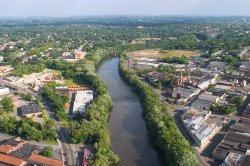Earth Day 2023: NJ’s Biggest Climate Challenges
Faculty experts weigh in on the environmental issues in the state that need attention and action
Posted in: Faculty Voices, Science and Technology, Uncategorized

More than half a century after the first Earth Day called for changes to human activities that negatively affect our environment, our planet continues to face dire challenges.
This year’s official Earth Day theme is “Invest in Our Planet.” Here, we’ve asked our science experts to identify some of New Jersey’s most important environmental challenges, what is currently being done to solve them and what else we can do to invest in the future of the Garden State.
Cyanobacteria harm our New Jersey waters, wildlife and us
While phytoplankton play an important role in a balanced ecosystem, too much of a good thing has proven to be dangerous in New Jersey and many other places. A harmful algal bloom (HAB) is the rapid growth of cyanobacteria in a body of water, leading to the production of toxins that have harmful and deadly effects on humans, domestic animals and wildlife. HABs can also negatively impact aquatic ecosystems by altering the water chemistry and reducing dissolved oxygen levels, leading to fish kill incidents.
The presence of HABs have prompted beach closures and advisories against swimming, fishing or boating across the state. In response to the growing concern, Montclair’s New Jersey Center for Water Science and Technology is helping to safeguard our valuable water resources by housing a certified lab that tests for cyanotoxins in water.
The Center also offers a visual guide for the public to be able to identify common freshwater cyanobacteria, and hosts a “Traveling HAB Lab,” a mobile education program that provides on-site, discovery-based activities to educate the general public on HABs and how to take actions to reduce water pollution and future blooms.
– Meiyin Wu, Professor of Biology and Director of the New Jersey Center for Water Science and Technology
New Jersey will experience more droughts and floods
One of the impacts of climate change on New Jersey will be more droughts and more floods. This might seem confusing, as one is too little water and the other is too much, but we are predicted to experience both.
Droughts have a variety of causes, but with future weather patterns being more variable and an increase in temperatures and evaporation, our water supplies will become more stressed and there will be times where available water is limited.
Conversely, warmer air can hold more water vapor, which causes more precipitation. This, combined with stronger hurricanes, a longer hurricane season and increased sea levels will produce more flooding on rivers and coastal areas.
– Joshua Galster, Associate Professor of Earth and Environmental Studies
Wildfires will become more frequent in New Jersey and beyond
Wildfires are among the many threats that are a byproduct of climate change. Rising temperatures and drought contribute to dry and stressed vegetation, which catch fire more easily. Yes, many ecosystems are used to periodic, natural, low-level fires, including grasslands, mountain forests or New Jersey’s own Pine Barrens – but these fires are expected and can benefit an ecosystem. Climate change makes the situation worse, with fires happening more frequently or severely, causing a number of consequences: long-term damage to an ecosystem, and impact on human health, infrastructure and natural resources.
With increasing human settlement in formerly wild areas (such as in mountain resorts, growing suburbs or mining and forest cutting areas), fires pose a growing risk. We have seen increasing reports of catastrophic fires in the past few years, in the western United States, Australia and the Amazon. Of course, New Jersey and its neighboring states are not immune. My colleagues and I investigate recent fires in the mountains of New Jersey and Pennsylvania; these may become more frequent or severe if drought conditions recur. Even distant fires impact New Jersey, such as the bad air pollution we experienced last summer from smoke from fires in Canada and the Northwest.
Ecosystems eventually adjust to new fire regimes, but that happens over hundreds of years. Human society cannot wait for that resiliency, so it is in our best interest to mitigate as best we can the inevitable effects of climate change, and plan carefully for these hazards.
– Greg Pope, Chairperson and Professor, Earth and Environmental Studies
We must keep investing in climate change education
In 2020, New Jersey became the first state in the U.S. to incorporate climate change education in its K-12 schools, via the New Jersey Student Learning Standards (NJSLS), with resources available in the New Jersey Climate Change Education Hub.
The work continues in higher education. Galster’s students, for example, conduct original research by analyzing water and sediment samples from numerous rivers. They see first-hand the amount of microplastics found in every sample, suggesting the size and reality of the microplastics problem in New Jersey.
“Not only are these important results, but the students are learning what it means to be scientists and how science works,” Galster says.
Wu, who oversees programming at the Center for Water Science and Technology, says young students will be the next generation of scientists, politicians, and other roles that will be making choices that impact the planet.
“It is critical to teach children the importance of clean and healthy ecosystems, environmental resources, and how they rely on and impact the environment.”
To speak with an expert, contact the Media Relations team.
